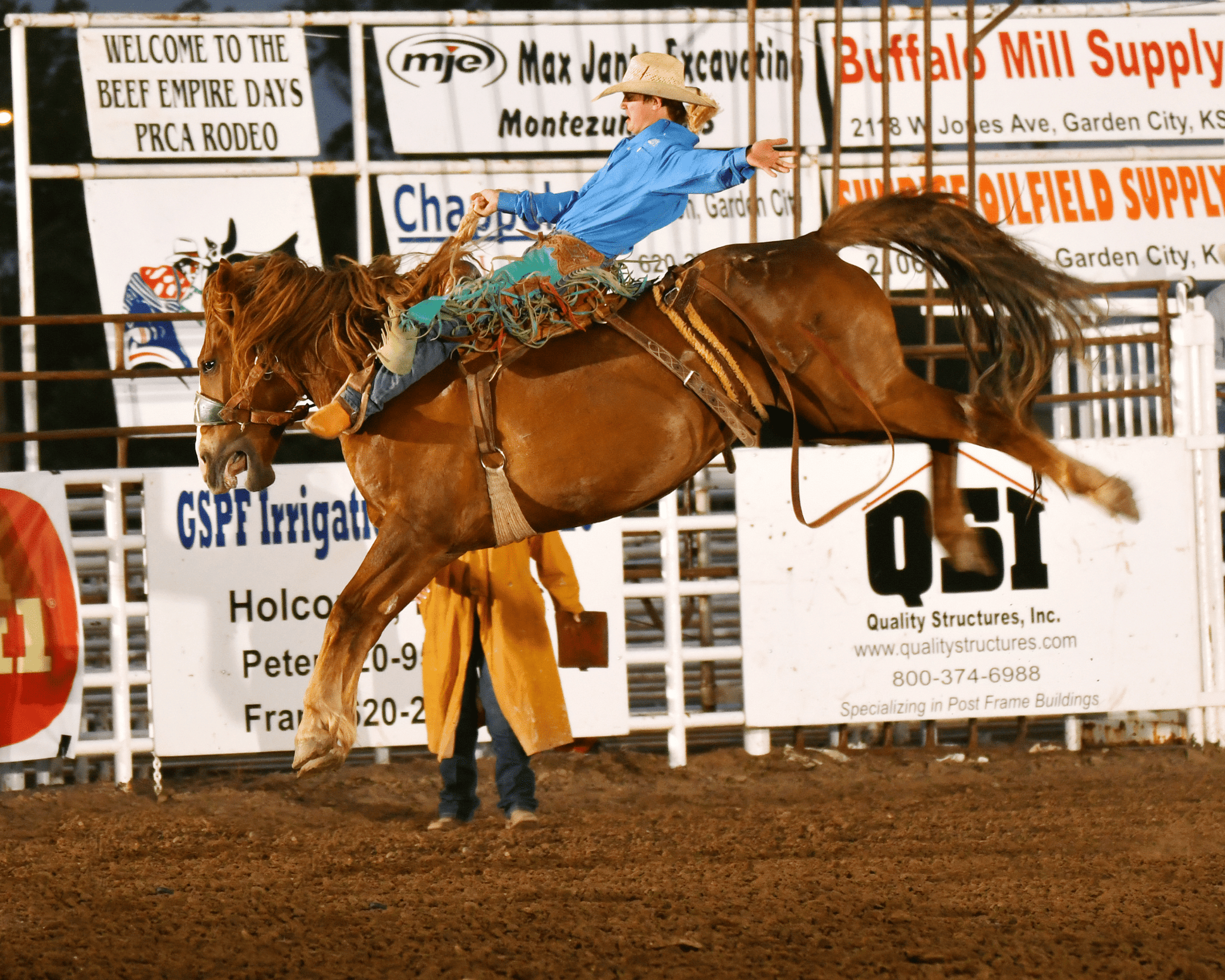Watching a rodeo is a good time, whether you know what’s going on or not. It’s about as American an experience as you can imagine. However, you can enjoy it a lot more if you have some idea of what’s going on.
This article is the third part of our three-part beginner’s guide to rodeo. In the first article, we presented an overview of the sport, and the second article covered timed events. Here we will take a look at the rough stock events, which are the events most casual observers are probably familiar with.
Rough Stock Events
Generally speaking, a rough stock event requires a cowboy to ride a wild, bucking animal for eight seconds. That’s it. The details vary slightly among the different events, but this core goal remains the same. And while it may sound simple, it’s far from easy.
Just as timed events test the finesse, skill, speed, precision, and awareness of cowboys and their horses, rough stock events test the balance, strength, will, grit, courage, and guts of the cowboy himself. It’s a battle for survival with an angry animal where one small mistake could mean disaster.
Bull Riding
This event is a rodeo classic, and probably the most recognizable to laymen spectators. Bull riding requires a competitor to remain on top of a bucking bull for eight seconds. During that time, he must hang on with one hand to a special braided rope attached around the bull’s chest. If he falls off before eight seconds pass, or if he touches anything with his free hand, no score is recorded for the rider.
Bull riding has no practical purpose and was never a traditional cowboy skill. It is simply a man-versus-nature-type test and a chance to compete with others. The event likely arose from Spanish bullfighting brought to the Americas by conquistadors before evolving into the modern competition we see today.
Winners are determined by a set of four judges, all of whom must be former riders themselves. Interestingly, rider and bull are judged separately, with two judges focused on the rider, and two focused on the bull. They can award a maximum total of 100 points for a ride, split evenly between the rider and the bull. An experienced pro riding a tough bull might produce a score of 75, while scores over 90 are rare and represent exceptional rides.
Riders are scored primarily on whether they can stay on the animal for eight seconds. After that, they are mostly measured for style, balance, rhythm, how well they control the bull, and whether the rider’s movements are in sync with the animal’s. Additional points are awarded if the rider has such good control that he can spur the animal to buck even harder. Points are deducted if the rider is out of balance.
For the bull, judges assess the animal’s speed, power, and agility. They want to see the hind legs kicking out and the front end dropping low. Basically, the judges score a bull based on how difficult that bucking monster makes the ride for the competitor. The harder the ride, the higher the score.
If a cowboy happens to ride a particularly calm and lazy bull, the judges will award the bull a low score. Even if the rider scores a perfect 50 points, he could still lose if the bull doesn’t cooperate. In this sense, bull riding is a team performance between cowboy and animal. If the bull is particularly low-scoring, the judges may give the rider a second chance after all the other competitors have ridden.
However, even if the rider falls off before eight seconds (and thus gets no score), the bull itself still receives a score. At the end of the year, the Professional Rodeo Cowboys Association (PRCA) gives the highest-scoring bull an award, which brings prestige to the ranch where it was bred and raised.
Bronc Riding
Bronc riding is similar to Bull riding with a few key differences. Of course, the main difference is that competitors ride a bucking horse (called a bronco) rather than a bucking bull. Another key difference is that the cowboy must have his heels touching the horse just above its shoulder blades at the start of the event. Failure to do so results in a disqualification.
Other than that, Bronc riding follows the same rules as bull riding. A competitor must stay on top of a bucking bronco for eight seconds to register a score. If the rider touches the saddle, the rein, or the horse, the rider will receive no score.
The judging for bull riding and bronc riding is similar as well. However, in bronc riding, it’s even more important for the rider to synchronize his movements with the horse. When the horse’s front is down, the rider’s heels must be forward. A high-scoring ride looks like a perfectly synchronized dance routine with the rider moving and flowing with the horse’s movements.
Bronc riding competitions can be either saddled or bareback. In the saddled version, riders use a special hornless saddle with free-swinging stirrups that allow the rider to move in sync with the horse. Instead of a horn, the rider grips a braided rein attached to the horse. In bareback bronc riding, competitors grip a kind of “suitcase” handle that attaches around the horse’s withers.
The skill of bronc riding was originally developed as a way to tame wild horses (also known as breaking) and turn them into work animals. While this isn’t necessary anymore today, the skill remains as a competitive pursuit at rodeo events.
These days, rodeo broncos are not wild horses, but instead are horses bred and trained specifically to participate in the sport. Rodeo broncs must have a delicate balance of wildness and docility. They are carefully selected for their bucking ability, yet must be trained to participate in the logistics of the sport.
Conclusion
Rough stock events are not for the faint of heart. While they depict an intense battle between man and nature, they also show how man and nature must work together to accomplish greater goals. After all, for a cowboy to win a rough stock event, the animal and cowboy must be in perfect sync. What appears to be a war is more like a dance.
This concludes our beginner’s guide to the rodeo. We hope you found this article series helpful and that you gained a little insight into what the rodeo is, how it works, and why it is loved by so many competitors and spectators.
If you are looking for other activities and events in Garden City, feel free to check out the other great content on our site.


